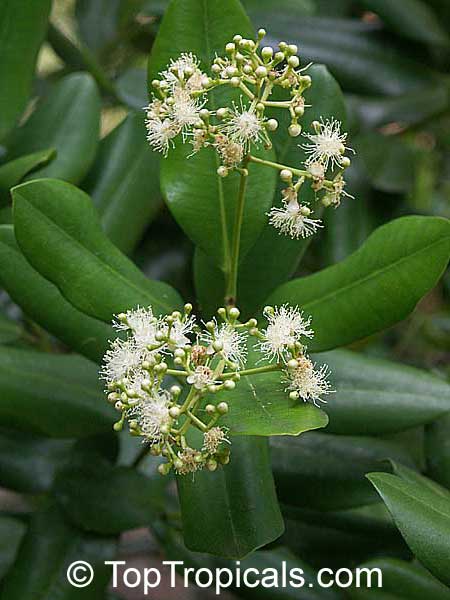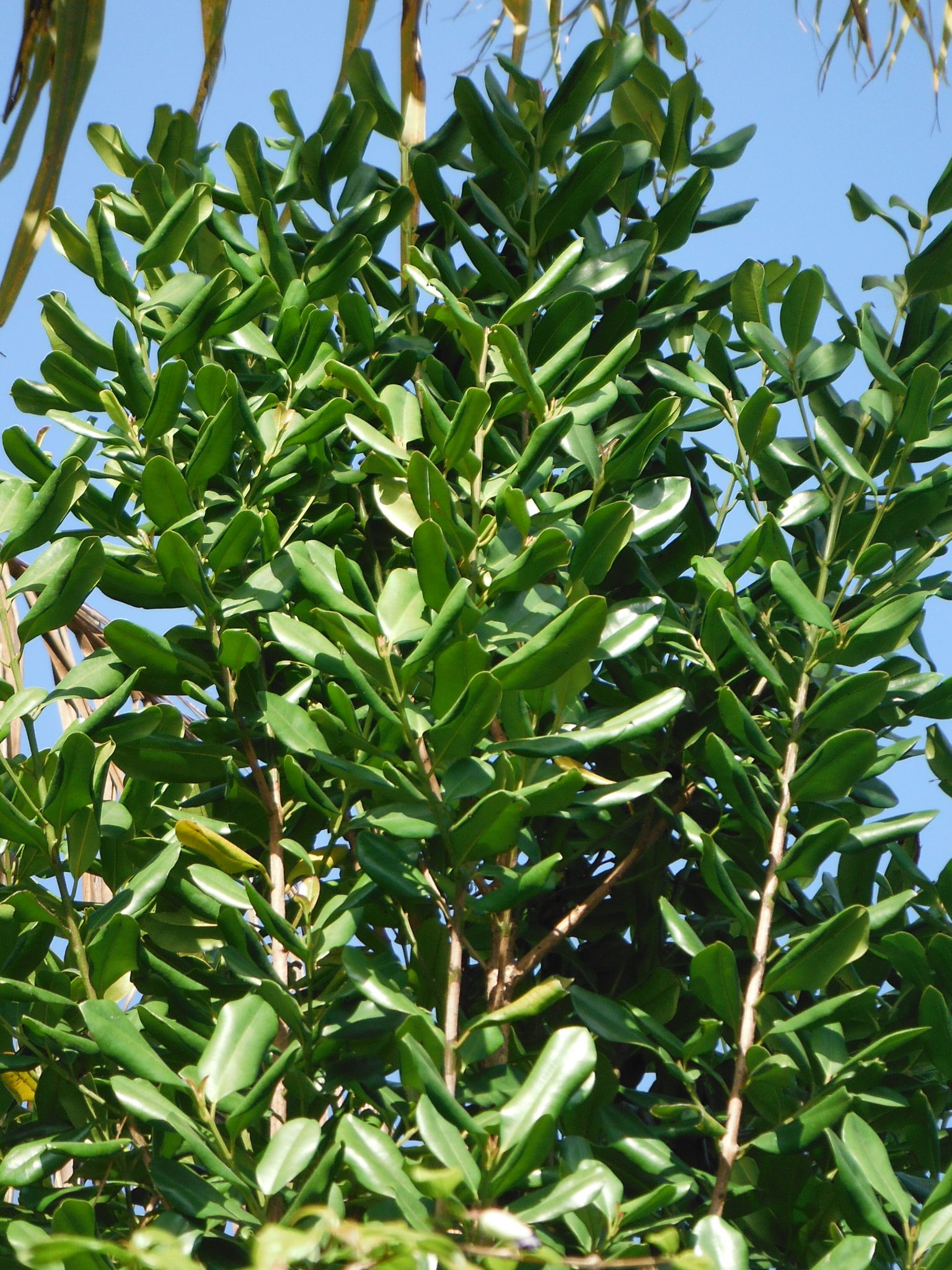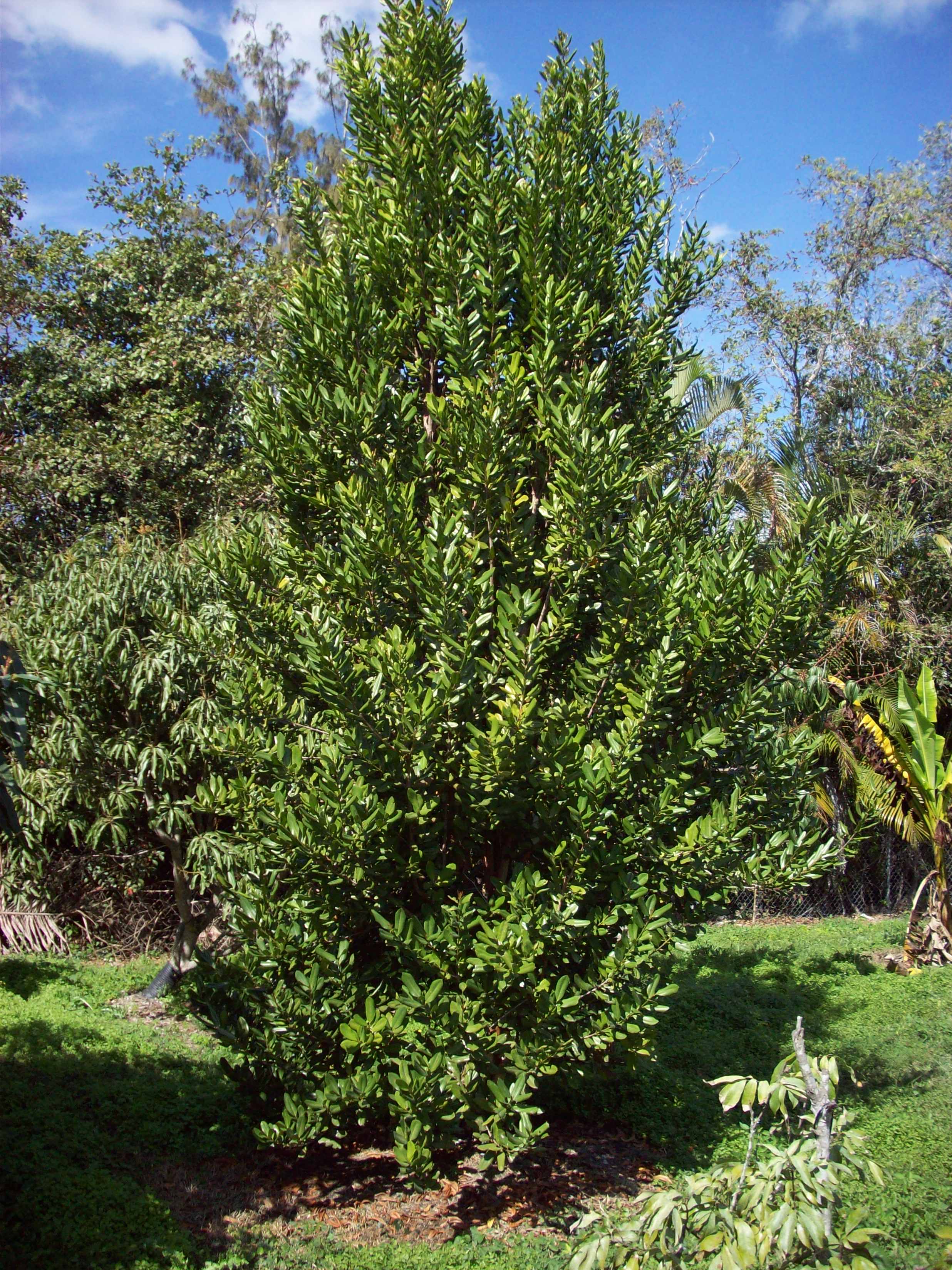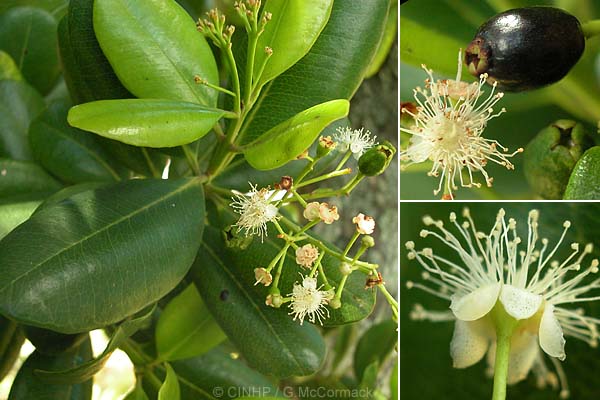Pimenta racemosa
Bay ( Pimenta racemosa )
Bay, Bayrumbaum or West Indian bay ( Pimenta racemosa ) is a plant in the myrtle family ( Myrtaceae ). It is native to the Caribbean Islands Anguilla, Antigua and Barbuda, Barbados, Cuba, Dominica, Grenada, Guadeloupe, Hispaniola, Martinique, Montserrat, Puerto Rico, St. Lucia, St. Vincent and the Grenadines, Trinidad and the Virgin Islands and comes in Guyana and Venezuela before. For example, in Hawaii and Fiji, it is grown and has run wild there. English-language common names are: bay rum tree and West Indian bay.
Description
Pimenta racemosa grows naturally as an evergreen tree, reaching heights of growth of usually 4 to 12 meters. The constantly against arranged on the branches leaves are divided into petiole and leaf blade. The petiole is 3 to 10 mm long. The simple, leathery leaf blade is at a length of usually 4 to 10 (1.5 to 12:5) inches and a width of 2.5 to 6 inches obovate to wrong - lanceolate or elliptic, blunt or pointed Spreitenbasis. There are five to six pairs of relatively indistinct lateral nerves and between them a fine Netznervatur available. The upper leaf surface is glossy and the lower leaf surface bright and dull.
On an inflorescence stem is a zymöser inflorescence. The white flowers are radial symmetry and a diameter of about 10 millimeters. There are five sepals present. The black when ripe fruits are egg-shaped with a length of 7 to 12 mm.
Use
The West Indian bay oil production is cut to a shrub to a maximum of 4 meters, so it can be easily harvested. Used the leaves that contain essential oil, which is recovered by distillation. Main component of the oil is eugenol, which is also found in clove ( Syzygium aromaticum ). In addition, it contains estragole. Bay oil was used in 1900 for the care of the scalp and was regarded as a hair restorer. Bayblatt distillate is sold under the name Bay rum aftershave.
Bay oil is characterized by a strong, spicy scent, reminiscent of clove oil. The antiseptic effect is detected, and therefore the oil is often used for colds along with eucalyptus oil for inhalations and baths. A calming effect on the neuro- vegetative nervous system is also said to have the oil.
The fruits are similar to those of pimento, but of poorer quality, and therefore less suitable as a seasoning.
Systematics and distribution
The Erstveröffentliung took place in 1768 under the name ( basionym ) Caryophyllus racemosus Mill by Philip Miller in The Gardeners Dictionary: ..., 8th edition, number 5 This species was found in several classes over time. The now accepted to Pimenta racemosa recombination (Mill.) JWMoore took place in 1933 by John William Moore in Bernice P. Bishop Museum Bulletin, Volume 102, S 33 The specific epithet means racemosa grapey.
Pimenta racemosa is native to the Caribbean islands of Anguilla, Antigua and Barbuda, Barbados, Cuba, Dominica, Grenada, Guadeloupe, Hispaniola, Martinique, Montserrat, Puerto Rico, St. Lucia, St. Vincent and the Grenadines, Trinidad and the Virgin Islands and is in Guyana and Venezuela before. For example, in Hawaii and Fiji, it is grown and has run wild there.
There are five varieties of Pimenta racemosa (Mill.) JWMoore:
- Pimenta racemosa var grisea ( Kiaersk. ) Fosberg ( syn: Pimenta acris var grisea Kiaersk, Amomis caryophyllata grisea var ( Kiaersk. ) Kiaersk, Amomis grisea ( Kiaersk. ) Britton. . ): It comes from the Dominican Republic to to the front of Virgin Islands.
- Pimenta racemosa var hispaniolensis ( Urb. ) Landrum ( Syn: Amomis hispaniolensis Urb, Pimenta hispaniolensis ( Urb. ) burret, Amomis pauciflora Urb, Pimenta pauciflora ( Urb. ) burret, Pimenta crenulata Alain. . ): It is endemic to Hispaniola.
- Pimenta racemosa var ozua ( Urb. & Ekman ) Landrum ( syn.. Amomis ozua Urb & Ekman, Pimenta ozua ( Urb. & Ekman ) burret, Amomis anisomera Urb & Ekman, Pimenta anisomera ( Urb. & Ekman ) burret. ): It is endemic to the northern - central Hispaniola.
- Pimenta racemosa var racemosa ( syn.. Myrtus caryophyllata Jacq nom illeg, Myrtus acris Sw, Myrtus citrifolia Poir, Myrcia acris ( Sw. ) DC, Myrcia pimentoides DC, Myrtus tabasco Willd ex Schltdl &. .. .. .. . Cham., Eugenia tabasco ( Willd. ex Schltdl. & Cham. ) G.Don, Myrtus pimentoides ( DC.) T.Nees, Pimenta acris ( Sw. ) Kostel. , Pimenta citrifolia ( Poir. ) Kostel. , Pimentus cotinifolia Raf. , Amomis oblongata var occidentalis O.Berg, Amomis acris ( Sw. ) O.Berg, Amomis acris var grandifolia O.Berg, Amomis acris var obtusata O.Berg, Amomis acris var parvifolia O.Berg, Amomis oblongata O.Berg, Amomis O.Berg pimento, pimento Amomis jamaicensis var O.Berg, Amomis pimento var surinamensis O.Berg, Amomis pimentoides O.Berg, Pimenta officinalis var tabasco ( Willd. ex Schltdl. & Cham. ) O. mountains, Pimenta acris var pimentoides ( DC.) Griseb. , pimento Pimenta Griseb. , Pimenta acuminata Bello, Amomis caryophyllata Krug & Urb., Pimenta dioica var tabasco ( Willd. ex Schltdl. & Cham. ) Standlschmaus. , Pimenta tabasco ( Willd. ex Schltdl. & Cham) Lundell ). It occurs on Caribbean islands and in northern Venezuela.
- Pimenta racemosa var Terebinthina ( burret ) Landrum ( syn: Pimenta Terebinthina burret ): It is endemic to the northeastern Dominican Republic.









